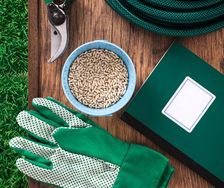Yates Account
Join now
Create a Yates account today!
Sign up to join the Yates Garden Club for monthly e-mails packed with seasonal inspiration, tips for success & exclusive promotions.
Plus if you’re a Garden Club member you can take part in the Yates Growing Community - a blog to share successes, get advice & win prizes in fun challenges along the way!

Forgot password
Enter the email address associated with your account, and we'll email you a new password.

Fiery Bidens
Bidens are a group of hardy plants in the daisy family, deservedly popular for their bright, warm colours. Bidens are available in golden yellow hues, shading through rich burnt orange into deep reds. Some cultivars have attractive bicolour yellow and orange petals. Bidens is a vigorous plant, growing to around 20-30cm tall and is heat and drought tolerant. Cooler temperatures will help promote the burnt orange tones.
In warmer areas, bidens can flower from winter through into spring and summer. In the cold winter zone, bidens look their best during the warmer months.
Bidens loves a garden spot with full sun. It looks fantastic planted along the edge of a retaining wall, or in a pot. If you combine them with other ‘hot' coloured flowers (try calibrachoa!), bidens makes a real statement.
When planting Bidens into pots or hanging baskets, start with a good quality potting mix like Yates Premium Potting Mix and feed each week with Yates Thrive Roses Flowers Liquid Plant Food. It’s boosted with extra potassium, the key nutrient that encourages flowering. Lightly trim your colourful creation regularly, to maintain a tidier look and keep new flushes of flowers appearing.

Alyssum Winter Wonderland
Alyssum is commonly grown as a pretty filler in amongst other flowers. It may not grab centre stage and it's often overlooked, but there's a reason alyssum is such a popular choice for annual colour! Alyssum makes a gorgeous border plant even when it is grown on its own.
Yates Alyssum Carpet of Snow is a long lasting and hardy annual, smothered in masses of tiny honey scented white flowers. In warm and temperate zones during June, it’s as easy as scattering seed direct where they are to grow, then only just covering with 2mm of loose soil or Yates Black Magic Seed Raising Mix. Firm down and keep the soil moist while the seeds germinate (which takes around 2 weeks). In cool zones, look for alyssum seedlings in your local garden centre.
Yates Alyssum ‘Carpet of Snow’ grows to a petite 10cm tall and starts flowering 2 months after sowing. To tempt you, here are some of our favourite colours to combine with crisp white alyssum:
- Plant violet or periwinkle-coloured violas amongst white alyssum in a trough or window box - the combination really pops.
- Contrast lemony yellow trailing pansies with white alyssum in a hanging basket. The pansies will spill beautifully over the basket edge and the alyssum softens the texture, but really accentuates the yellow hues.
- In a garden bed, purple or lavender salvias at the rear and a swathe of white alyssum at the front is a pretty sight.
- Plant white, violet, magenta and pink alyssum varieties together, for a harmonious, muted pastel display.
Before sowing seed or transplanting seedlings, enrich the soil or potting mix beforehand by incorporating some Yates Dynamic Lifter Organic Plant Food. It adds valuable organic matter which benefits soil structure, encourages earthworms and beneficial soil microorganisms and helps hold moisture in the soil. It will also provide organic slow release nutrients to the alyssum as they establish.
Protect seedlings from damaging snails and slugs with a light sprinkling of Yates Blitzem Snail & Slug Bait, then feed the alyssum plants every week with Yates Thrive Roses & Flowers Liquid Plant Food.
It will encourage strong healthy plants and lots of snowy white flowers. Trim the plants back regularly to help keep them tidy and encourage new growth and flowers.
Did you know? Alyssum attracts beneficial insects into the garden, so it’s not just pretty; it's clever too!

Elegant Moth Orchids
Phalaenopsis orchids, more commonly known as ‘Moth’ orchids, are native to tropical Asia and are a stunning type of orchid that make a beautiful potted plant. The flowers are long lasting and moth orchids can live for many years, so they’re a worthwhile and very pretty investment. It’s like receiving a bunch of flowers every day for weeks!
The long, fragile looking flower spike can make moth orchids appear daunting to care for, however by using a few simple steps they can be an easy and rewarding plant to grow and can even re-flower for you.
- Moth orchids naturally grow within the canopy of trees, attached to tree trunks. When grown in a pot, they need the same free draining environment so are planted into chunky, well drained orchid mix and often their roots will grow spider-like out and over the edge of the pot, similar to the way they would grow over and around tree trunks in the wild.
- They love humidity and bright but indirect light. Don’t place moth orchids next to an air conditioner, heater or hot westerly facing window.
- Every one to two weeks, water the orchid below the foliage, as moisture pooling in the crown or remaining on the leaves can encourage disease. A small watering can with a narrow spout is ideal. Overwatering can lead to the demise of your lovely orchid, so allow it to almost dry out between waterings. During particularly hot and dry weather, the overhanging roots can be misted with water every day.
- You can sit your potted moth orchid on a saucer that’s filled with pebbles and regularly add water to the saucer. This creates a more humid environment around the plant but doesn’t allow the roots to be permanently sitting in water.
- To keep moth orchids well-nourished and give them the best chance to re-bloom, they should be fed regularly with an orchid food like Yates Thrive Orchid Liquid Plant Food, which has been specially designed to promote beautiful flowers and healthy green leaves. Any excess diluted fertiliser can be used to feed other flowering plants.
- Moth orchids are usually sold with their flower spike supported by a small stake. Keep this stake even after the flowers fade, as it can be used again for the next flowering season.
- Cooler temperatures at night encourage the development of flower spikes so look out for newly developing flower spikes in autumn.
- Monitor moth orchids for sap sucking insect pests like scale and mealybug, which can deplete plants, cause leaf yellowing and promote the growth of sooty mould fungus. Spraying the foliage with Yates Bug Oil Conqueror Oil Insect Spray Ready to Use or Yates Conqueror Spraying Oil will help keep these insect pests under control.
Klare’s Tips:
One of Yates’ fantastic horticulturists (and self-confessed orchid fanatic) shares this top moth orchid tip: after flowering, encourage more flowers by pruning the flower spike back to just above the second node from the base. A new branch will then emerge from that point, together with flower buds.
















Share
Share this article on social media